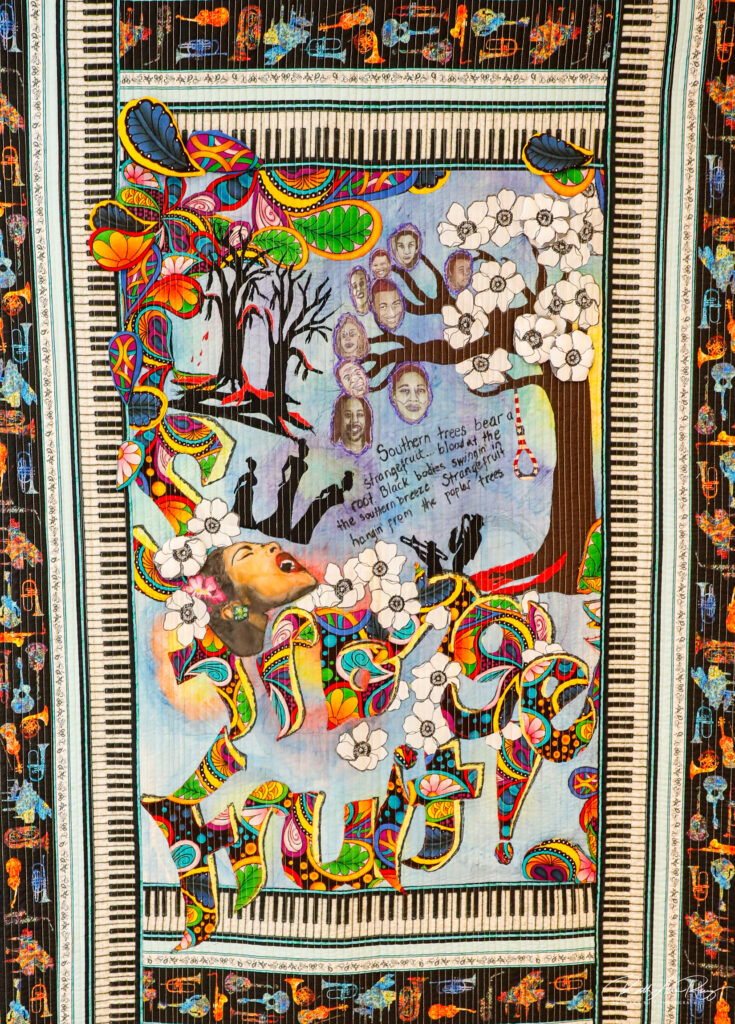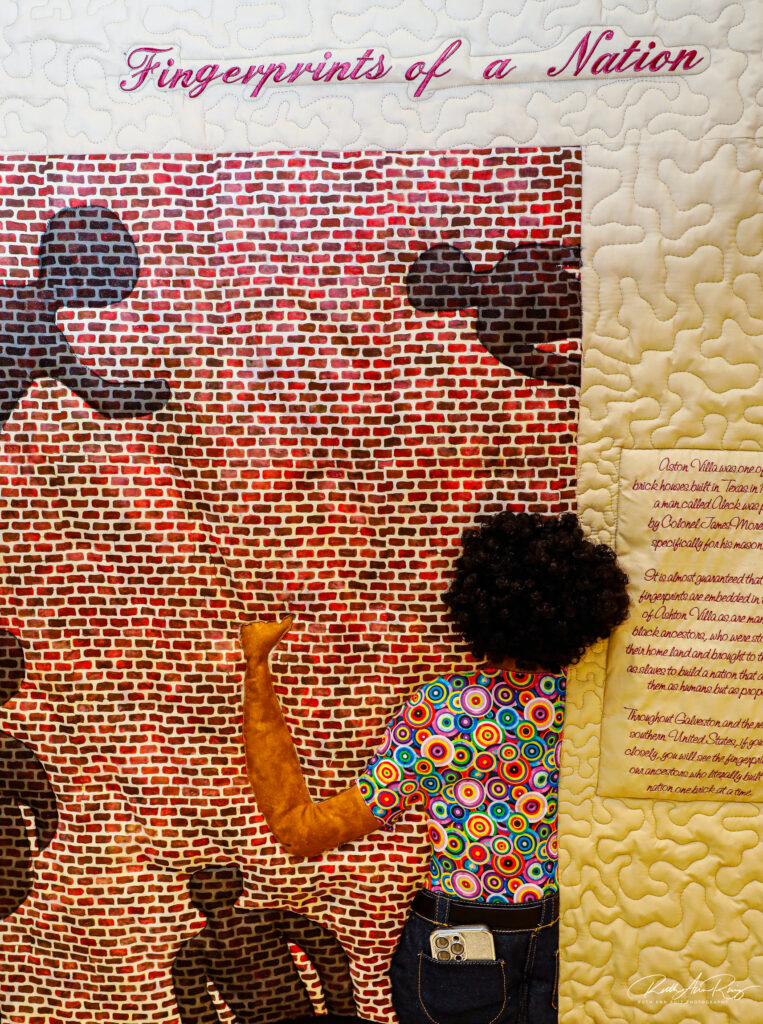
By Ruth Ann Ruiz
The Post Newspaper Features Editor
Three quilters whose spirits bubbled out like three teenage girls were giggling and giddy about the joy of their work and the joy of speaking with the many guests who had come in to appreciate their talent and their message.
Their work was exhibited at Nia Cultural Center for Saturday evening’s Art Walk in Galveston.
Cynthia Dixon, Kimberly Dunbar, and Michelle Sillimon created quilts specifically for the Nia Cultural Center along with exhibiting other examples of their works, one of which had been on exhibit in Paris.
Dunbar’s quilt, the one that had been exhibited in Paris, is outlined with a black fabric printed with musical instruments moving into another border with piano keys. The musical prints lead the viewer to focus on the theme of her piece, which is a take on Billie Holiday’s song “Strange Fruit.”
The quilt is filled with swirls of bright colors and gives a feeling of something going on that seems to be a bit of a dream and maybe not a pleasant dream. But the puffs and swirls of bright colors tone down the unpleasantness of the dream, allowing a viewer to stop and experience the message.
The message of her quilt is like that of the Billie Holiday’s song, a tribute and reminder of the tragic loss of Black lives in America through lynchings and other forms of violence.
Making people stop and think is one of the main drivers behind what Dunbar creates.
“I like to push the envelope,” shared Dunbar. “I do a lot of research for each of my pieces, and I am inspired by Black Americans.”
Her quilting sister, Cynthia Dixon, brags about Dunbar’s expertise.
“Kimberly can make an exciting quilt in just one week,” Dixon shared.
Dixon’s work is quieter than that of her sister quilter. Her work, as demonstrated by her floral pieces, has more of a focus on showcasing the culture that Black Americans have derived from Africa. Dixon has been quilting for ten years.
“Quilting is my happy place,” Dixon said.
She was inspired by a quilt her grandmother made for her.
“My grandmother gave me one of her quilts, and I loved on it and shredded it till it shrunk away. So, I vowed to learn how to quilt someday,” shared Dixon who is dressed in a long lilac-colored dress and a matching scarf tied in a bow across the side of her head.
While at work, Dixon spied a quilt hanging in the office of a coworker.
“I asked her if she could teach me how to quilt, and she told me, ‘Sure, it would be easy.” Dixon shared. “Then, when I got started, I realized quilting is not easy,”
Dixon went on to explain that quilting is more than just cutting and sewing.
“It’s a process of stopping to think about what you want to create and how you will create your piece,” she explained.
From the looks of each woman’s work, it is obvious that quilting today is not what it was in generations from the past. Today’s quilters are using more than just sewing skills. They transform the colors and shapes of fabrics and add touches, such as a mock cell phone in a jean pocket to tell a story.
Fabric printers are a tool used to create images used on some of the ladies’ quilts and other objects such as strings of beads are added to their artistic expression. Their quilting skills tell stories with more than a needle and thread.
One of Michelle Sillimon’s quilts, which she created specifically for Nia Cultural Center, employed the use of a green piece of fabric that she painted. The story she depicts in this special creation is the story of the bricks with fingerprints from the enslaved people who formed the bricks.
Along the border of her hand-painted bricks are what look like silhouettes of human shapes. Sillimon explained she intended for these to be shadows of the people who are taking photos of the bricks. There is a 3D image of a young person looking at the bricks.
Sillimon uses material that represents hair in many of her pieces at the exhibit, adding a touch of modern décor to her pieces.
The ladies explained that they create their work from their own visions and enjoy the freedom of expression that they experience with each new piece they craft. Their work is often exhibited in shows throughout the region and occasionally in other nations.
The ladies explained that exhibitions of a quilt have about a four-year life span. Then the ladies will keep their work at home. Some of their quilts are gifted to family and friends and some of their work is sold.
Beyond creating quilts, what the ladies agree they enjoy the most is the friendships they are forming with fellow quilters.
Together with other quilters, they plan quilting sessions at public libraries, where they bring their materials and share a day of creating their individual pieces.
To escape from jobs and other daily grinds, they also participate in four-day quilting retreats in Magnolia, Texas twice a year.
Each of them is a member of the Houston Modern Quilt Guild.
“I love my fellow quilters and the knowledge we share with each other as we create together,” shared Sillimon, who turned to quilting to work through the loss of her husband three years ago. “I love how we are expressing ourselves.”



